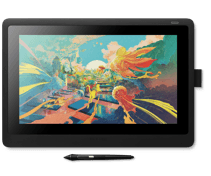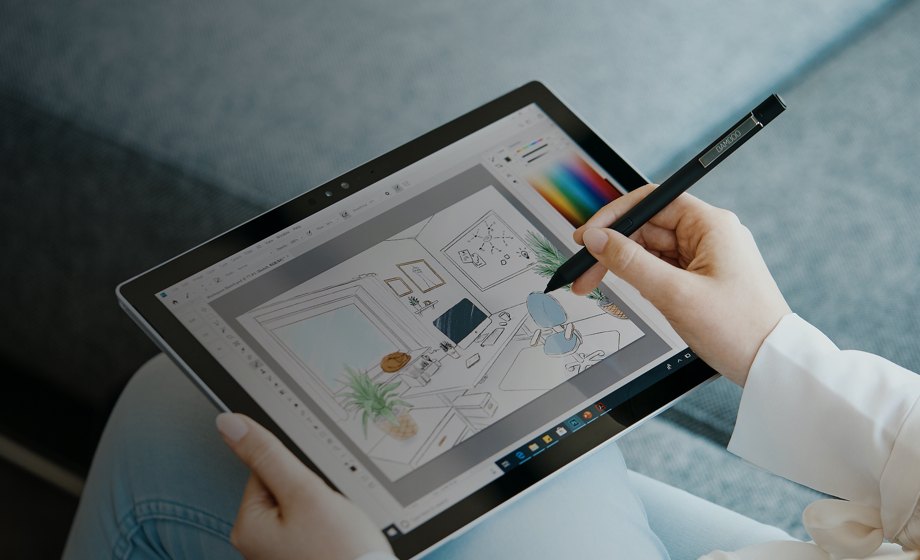Mesas digitalizadoras
Esboce, desenhe e edite imagens com um teclado sensível, uma caneta precisa e veja suas criações aparecerem na tela.


Seja criando seu próprio logotipo ou desenvolvendo técnicas de design gráfico para ajudar a tornar ícones, cartões de visita ou sites visualmente atraentes, este guia oferecerá conselhos claros sobre como tornar-se um melhor designer, não importa qual seja o trabalho.

A criação de seu próprio logotipo requer muita pesquisa. Em primeiro lugar, passe algum tempo online observando logotipos clássicos e o que eles têm em comum. Depois, faça um painel semântico, usando impressões de seus logotipos favoritos para criar um lembrete visual do que você espera alcançar. Antes de ligar seu computador e abrir o software de ilustração, reserve algum tempo para esboçar ideias com caneta e papel, lembrando-se de manter até mesmo o mais básico dos rabiscos – nunca se sabe quando eles podem vir a ser úteis. Se estiver fazendo o logotipo de uma marca, confira se ele está de acordo com sua identidade mais ampla, desde as fontes utilizadas nos sites até a forma como ele se posiciona no mercado.
Quando se trata do design real de seu logotipo, vale a pena simplificar as coisas. Lembre-se de que os logotipos mais famosos são ilusoriamente básicos, tornando-os mais fáceis de serem lembrados pelas pessoas. Para que se destaque, vale a pena aprender a fazer tipos de letra personalizados, usando cores que delineiam o olho. Se isso parecer muito desafiador, você pode usar fabricantes on-line e criar um logotipo simples para sua marca pessoal ou start–up.

Uma abordagem simples é necessária quando se trata de projetar um papel timbrado. Deve inspirar-se na identidade de uma marca, utilizando os mesmos temas e cores encontrados em sites e cartões de visita.
É importante usar ferramentas de software de desenho vetorial para fazer um papel timbrado. Isso permite dimensionar os projetos para cima e para baixo sem perder qualidade. A chave técnicas de design gráfico de hierarquia e alinhamento também entram em ação – decida se um papel timbrado deve principalmente mostrar um logotipo ou nome comercial e posicioná-lo corretamente.
É vital lembrar que uma carta serve para comunicar uma mensagem específica, sendo o próprio papel timbrado um componente secundário, embora importante. Com isso em mente, tente não usar cores em excesso e mantenha um mínimo de desarmonia no topo da página. Os detalhes de contato sempre podem ser colocados na parte inferior da página como forma de maximizar todo o espaço em uma página A4.

Os cartões de visita ainda são essenciais no mundo moderno, mesmo na era digital. E, embora possa ser tentador solicitar um serviço on-line para produzir um cartão para você, projetar o seu por conta própria ajudará a tornar você e sua marca mais atraentes.
Há algumas regras básicas a serem consideradas. Certifique-se de que qualquer texto esteja a 5 mm da borda do cartão; tenha um tamanho mínimo para os tipos de letra, para que os detalhes possam ser lidos facilmente; e use cores básicas para manter a simplicidade. Um design de grade é um bom lugar para começar, significando que a hierarquia é facilmente mantida. O tamanho ideal deveria ser o mesmo de um cartão de crédito, para que o cartão possa ser guardado facilmente na carteira.
Lembre-se de avisar o serviço de impressão, quando você tiver produzido seu cartão, informando que pretende utilizar qualquer técnica especial que possa ajudá-lo a ter um aspecto diferente. Cortes tipo matriz, acabamentos tipo lâmina ou cantos arredondados fazem com que os cartões de visita se destaquem dos restantes.

O web design é uma carreira independente. Mas isso não significa que você deva ficar para trás na aprendizagem de conceitos básicos e ao tentar construir seu próprio site, seja para um cliente ou para sua própria marca.
Embora o web design evolua rapidamente, existem algumas regras simples a seguir. Certifique-se de haver compreendido o que seu site está tentando alcançar, antes de começar a projetá-lo. Isso significa uma página inicial clara e simples, com convites óbvios para agir, especialmente importante se o site estiver vendendo algo. Também vale a pena pesquisar as tendências atuais em web design – compreender a moda do 'brutalista' e a aparência mínima ajudará você a se inspirar e decidir se quer que seu site tenha a mesma aparência dos outros ou se destaque na multidão.
Há uma infinidade de ferramentas on-line para ajudá-lo a construir seu site, muitas vezes com modelos de texto prontos para refletir que tipo de site você está construindo. Estes são inestimáveis e representam a espinha dorsal de qualquer site bom. Mesmo com ferramentas tão poderosas, vale a pena entender a teoria das cores, bem como os conceitos básicos de design, como o 'formato F'. Este último significa que as informações mais importantes de um site devem seguir o formato da letra F, com base na forma como os olhos dos usuários registram a página em uma tela.
Os ícones são produzidos em conjuntos, significando que eles precisam trabalhar bem juntos e pertencer a um grupo. Para fazer isso, é importante começar com formas simples – um ícone deve ser desenhado usando círculos, triângulos ou quadrados, antes de ser refinado.
Projetos iniciais dentro de uma grade definida e uma borda dedicada significam que cada ícone terá o início de um visual uniforme. Depois, é o caso de dar vida a seus esboços em papel usando um software de design. A consistência é fundamental. Isso significa acrescentar uma pequena característica, como um corte de canto ou uma curva a cada ícone, de modo que eles estejam obviamente relacionados. Vale a pena evitar curvas desenhadas à mão, em vez de contar com o software para adicioná-las aos designs a fim de que fiquem perfeitas o tempo inteiro.
Como os ícones tendem a ser pequenos, especialmente nas telas dos smartphones, é essencial manter os pixels alinhados. Qualquer ângulo em um ícone que não tenha sido alinhado corretamente pode aparecer em formas irregulares e mal montado.
Como em todo bom design, a simplicidade é essencial, ainda mais quando se trata de ícones. Os designs floridos e excessivamente ilustrados serão difíceis de distinguir e farão com que os ícones pareçam excessivamente minuciosos.

Uma identidade visual deve refletir em toda a marca, desde seu site, cartões de visita, logotipos, esquemas de cores e fontes. Antes de se preparar para projetar todos esses elementos, é importante realizar uma pesquisa sobre as pessoas que interagem com uma marca, bem como entender exatamente o que a marca está tentando conseguir. As respostas a essas perguntas garantirão que você tenha uma boa base para criar uma identidade visual. Elas revelarão se a aparência deve ser séria ou irreverente, moderna ou tradicional.
É essencial que uma identidade visual seja consistente. Isso significa usar as mesmas cores em todos os aspectos e entender que cores diferentes podem evocar emoções diferentes. Se uma marca produz aplicativos destinados a melhorar a saúde mental, o uso de um azul relaxante será melhor do que um vermelho arrojado, por exemplo. As fontes devem ser as mesmas ao longo de todo o processo, sendo utilizados não mais do que dois tipos. Isso tudo deve se complementar e ser utilizado consistentemente para as mesmas iniciativas em um site, papel timbrado ou cartão de visita.
Certifique-se de que quaisquer imagens utilizadas em materiais promocionais ou on-line reflitam a missão da marca e das pessoas que a utilizam. Uma identidade visual bem elaborada pode ser facilmente minada por imagens que não se encaixem na marca como um todo.
O que quer que você esteja projetando, a Wacom Cintiq coloca você no controle total. Cores vibrantes, nitidez de HD e design ergonômico, juntamente com a super-sensível caneta Pro Pen 2, oferecem uma experiência natural e ajudam a levar suas ideias criativas até o próximo nível. Os resultados falarão por si mesmos.
Produto recomendado

Wacom Cintiq 16
Desenhe, projete e crie diretamente em uma tela de alta resolução com uma caneta precisa.

Esboce, desenhe e edite imagens com um teclado sensível, uma caneta precisa e veja suas criações aparecerem na tela.

Desenhe, projete e crie diretamente em uma tela de alta resolução com uma caneta precisa.


Escreva e anote ideias rapidamente em seu dispositivo móvel com uma caneta Wacom.
A visão da Wacom é aproximar as pessoas da tecnologia através de tecnologias de interface naturais. Isso a transformou na fabricante líder mundial em mesas digitalizadoras e monitores interativos, bem como em canetas digitais e soluções para guardar e processar assinaturas digitais. A tecnologia avançada dos dispositivos de entrada intuitiva da Wacom foi utilizada para criar alguns dos exemplos mais interessantes de arte digital, filmes, efeitos especiais, moda e designs do mundo inteiro e fornece aos usuários comerciais e domésticos sua tecnologia de interface líder para expressar sua personalidade. Fundada em 1983, a Wacom é uma empresa global com sede no Japão (Bolsa de Valores de Tóquio 6727) com filiais e escritórios afiliados em todo o mundo para apoiar o marketing e a distribuição em mais de 150 países.